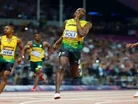Olympians given food for thought

Written by: Matthew Staff
So, the Rio de Janeiro Olympics and Paralympics are only about three years and 11 months away, and with the next installment of sporting greatness already on the horizon, planning begins now for the thousands of budding athletes around the world dreaming of future gold medals.
Jogging around the parks, swimming the lanes and cycling the roads may take care of the technical aspects, but there is one side of sporting preparation that simmers quietly in the background at all times for an elite athlete.
Olympians and Paralympians are expected to stick to tailor-made diets for their specific discipline, requirements and body shape at all times in order to excel when the all important time comes in the heat of battle, and sports nutrition has become one of the biggest buzz words in the modern sporting era.
Enabling the enhancement of physical performances across all sports, the intake of certain foods and drinks are critical in not only defining the sporting body, but also breaching social boundaries of eating disorders and substance abuse.
‘Get drunk once or twice’
You may think that sports nutrition is an entirely contemporary concept that has only had a role to play in the athletes of the 20th and 21st centuries. And, for the most part, you’d be right.
However, going back to the origins of Olympia and a declared link between dietary decisions and sporting prowess are even evident then. The advice of Hippocrates in the ancient games was to ‘get drunk once or twice’ to cure sore muscles, turn to dairy or meat to find that extra boost when flagging, and to avoid wine, desserts and cold water while competing.
Eight drunken javelin throwers or balance beam gymnasts may not fit in with today’s health and safety regulations admittedly, but many of the concepts transcended over the centuries of sporting competition, and since the inception of the modern Olympics in 1886, the role of the diet has become ever-more prevalent.
The balance of minerals, vitamins, proteins and carbohydrates are no longer pondered upon by the baffled athlete themselves, but by the rather well paid nutritional scientists and doctors employed by coaching teams to ensure every ounce of fluid or food entering the body is accounted for and part of the long-term plan.
Aiding performance
Boxers have often been singled out by the world’s media in the past in regards to their fluctuations in size and diets, due to the nature of a sport in which competitors can switch between weights categories and body shapes. This certainly isn’t the case in every sport though, further emphasising the necessity for athlete-specific regimes to be produced.
Even once the laborious and strict process of preparing for an Olympics or Paralympics is finished though, and the stadia begin to fill with expectant spectators, the monitored intake of nutrients still isn’t over. In the 1960s, researchers in Florida contributed to the drink now known as Gatorade, which is consumed right before, and during, intense competiton. This glucose and sucrose based drink is one of many that can be bought off the shelf to improve stamina and strength over long periods of sustained exertion, in what is now a multi-million dollar industry.
If you watch a tennis player in between changeovers, these drinks and specially made liquid foods will still be accompanied by the more traditional and natural banana, but finding the balance between the two as the sciences and technologies continue to advance is becoming more and more difficult.
A fine balance
Issues revolving performance enhancing drugs have raged on for decades now, heightened by incidents including the US team’s blatant testing of testosterone in 1956, or Ben Johnson’s too-good-to-be-true performance in Seoul in 1988.
Could we now be at a stage though, where the diet is questioned in equal measures to drug abuse? Afterall, in its most basic sense, athletes who are banned and labeled as drug cheats are done so due to them taking an unfair advantage through the substances going into their body prior to competition.
If nutritional science gets to the point where the foods and drinks consumed by athletes improves their stamina, strength or abilities, where do the ethical boundaries lie?
It is a fine balance within the Olympic and Paralympic community that will have to be monitored closely over the coming years, and is one of many.
Breaching everyday, social walks of life in elite sport carries risks, whether it relates to eating disorders within gymnastics and young teenage girls or the notion of planting the world’s largest McDonald’s in the middle of the Olympic Village for corporate reasons.
Food and drink plays a much bigger role in the development of sport and the athletes within these sports than it appears from the outside, but, with only three years and 11 months to get themselves in the best condition of their lives, there’s hardly time to waste pondering such implications. It just needs to be done.



